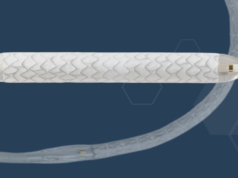
Two-year target vessel-related freedom from all-cause and aneurysm-related mortality for an off-the-shelf multibranched endovascular device for the treatment of thoracoabdominal aortic aneurysms (TAAAs) came in at 78.5% and 98.6%, 2022 Vascular Annual Meeting (VAM) attendees heard.
The data relate to clinical outcomes and target vessel patency in patients who underwent endovascular TAAA repair with the Zenith t-Branch in the first company-initiated, real-life registry of a patient pool covering elective, symptomatic and ruptured TAAAs.
Nikolaos Tsilimparis, MD, from Ludwig Maximilian University in Munich, Germany, reported the results during the International Fast Talk session that took place at the VAM 2022 in Boston (June 15–18).
The analysis was carried out at three European sites between 2012–2020 on repairs in patients receiving t-Branch and bridging stents for the celiac (CA), superior mesenteric (SMA), left renal (LRA), and/or right renal arteries (RRA).

Eighty patients (mean age 71.0) were enrolled—six patients had symptomatic TAAAs, with 15 patients having contained ruptures. Technical success was achieved in 98.75% of patients. Median follow-up was 22.2 months. Beyond 12 months, 38 adverse events occurred in 20 patients, including two aortic ruptures (one study aneurysm and one non-study aneurysm) and six deaths (none aneurysm-related), Tsilimparis told VAM.
Tsilimparis said the research team went through each target vessel in order to determine how each of them performed. Throughout the study duration, two patients had bridging stent compression, including covered and uncovered CA stents in one patient, and a covered LRA stent in the other, he revealed. Freedom from secondary intervention was 76.3% at 24 months. Seven patients had nine endoleaks (seven Type III and two Type Ic) involving bridging stents. Fourteen target vessel-related secondary interventions were performed, primarily consisting of stent placement for endoleak, stenosis, or occlusion. One reintervention involved bridging stent placement as part of a staged procedure. Freedom from loss of primary patency were 94.8%, 100%, 91.3%, and 89.3% for the CA, SMA, LRA, and RRA, respectively, at 24 months. Freedom from loss of secondary patency in the CA, SMA, LRA, and RRA were 96.3%, 100%, 98.2%, and 98.3%
“The celiac artery with the bridging stents seemed to do very well: the first year there were only a few occlusions, and primary and secondary patency were high. The two-year results were pretty similar to one year,” Tsilimparis explained. “After the few occlusions, there was a stable finding. The superior mesenteric artery was the vessel that performed the best and had the least concerns, with 100% patency at two years. More challenging were the renal arteries.”
He concluded, “At two years, specifically looking at target vessels, the results are supportive of the safety and effectiveness of the device and the technique and, of course, we need long-term data.”












